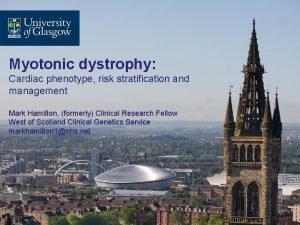Type 2 Myotonic Dystrophy Associated with Thyroid Cancer

- Slides: 1

Type 2 Myotonic Dystrophy Associated with Thyroid Cancer Issac Sachmechi, MD, FACP, FACE; Anuradha Chadha, MD; Preaw Hanseree, MD. Department of Internal Medicine, Queens Hospital Center, Mount Sinai School of Medicine, New York Introduction Myotonic muscular dystrophy (MMD) is an autosomal-dominant, multisystem disorder, characterized by muscle weakness, frontal baldness, premature cataracts, cardiac disturbances, and intellectual impairment. The endocrine system is commonly involved, including primary testicular failure, insulin resistance, and different thyroid diseases. On rare occasions, cases of thyroid neoplasm (3 papillary, 3 medullary, 6 unknown type) associated with myotonic dystrophy has been reported in literature. We describe first reported case of male with myotonic dystrophy associated with 3 thyroid disorders; multinodular goiter, subclinical hyperthyroidism, and follicular thyroid cancer. Case Report Summary of type of tumor and number of cases in literature in patients with myotonic dystrophy type 1 and type 2 A 64 year old male with past medical history of muscle weakness, hyperlipidemia, and depression presents in a wheelchair for fine needle aspiration of a thyroid nodule. Patient first noticed to have proximal muscle weakness 20 years ago that gradually progressed. He became wheelchair bound for the past 8 years. Patient experienced complete heart block which require placement of pacemaker in 1987. Patient also has bilateral cataracts and sexual dysfunction. On physical examination patient was bald, thyroid gland was enlarged, estimated 300 g with multiple nodules, gynecomastia was noted, and decrease muscle strength with muscle atrophy all extremities. Laboratory tests were significant for subclinical hyperthyroidism; TSH 0. 19 (0. 34 -5. 6) m. IU/m. L, T 3 77. 8 (87 -178) ng/d. L, T 4 8. 12 (6. 09 -12. 2) mcg/d. L, free T 4 0. 87 (0. 58 -1. 64) ng/d. L, and hypogonadism; testosterone 184 (212 -755) ng/d. L, FSH 24. 12 (<22) IU/L, LH 26. 42 (7 -24) IU/L, prolactin 16. 57 (1 -20) ng/m. L. Thyroid sonogram showed multinodular goiter, the largest nodule was 6. 5 cm in right lobe. Fine needle aspiration of this nodule revealed follicular lesion, surgical pathology confirmed follicular thyroid cancer. Post surgery received I 131 ablation therapy and maintained on levothyroxine suppression therapy. Unfortunately he passed away at home after chocking a piece of meat. Type of Tumor Number of cases Thyroid Carcinoma 12 Thyroid Adenoma 1 Thyroid Goiter 2 Skin cancer 25 Brain 8 Lung 13 Breast 16 Colorectum 19 Other GI track 12 Urinary organs 7 Endometrium 12 Ovary 9 Prostate 11 Hematologic malignancies 12 Other sites 46 Total 205 Discussion As myotonic dystrophy results from unstable neucleotide repeat expansions CTG (in type 1) and CCTG (in type 2) which may predispose these patients to develope cancer. Daumerie et al studied the CTG tripet expansion of DMPK gene in a patient with type 1 myotonic dystrophy associated thyroid nodular disease and reported 7 times larger amplification was found in abnormal thyroid tissue compared to lymphocytes, suggesting that anomalies in the DMPK gene might contribute to thyroid dysfunction. Win et al studied cancer risk among 307 patients with myotonic dystrophy type 1 and type 2 and reported an increase risk of thyroid cancer and choroidal melanoma. They observed 6 -fold increased risk of thyroid cancer compared with general population. However, Gadalla et al conducted larger multinational study including 1658 myotonic dystrophy patients and identified increased risks for cancers of the endometrium, brain, ovary, and colon, but not thyroid cancer. Our reported case has 3 different abnormalities in thyroid gland including multinodular goiter, subclinical hyperthyroidism, and the first reported case of follicular thyroid cancer in type 2 myotonic dystrophy. Conclusion Till now an association between myotonic dystrophy and thyroid cancer remains unclear. Further research is needed to definitively address this association and to understand the biological mechanism.

